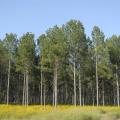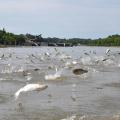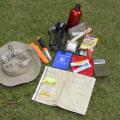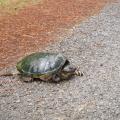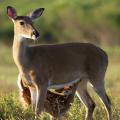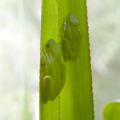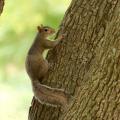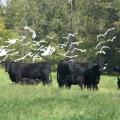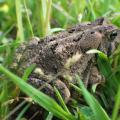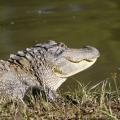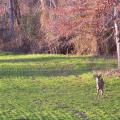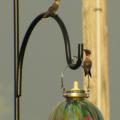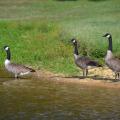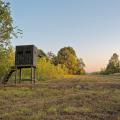Extension Outdoors from 2015
STARKVILLE, Miss. -- Summer is a critical season for white-tailed deer, especially in the Deep South.
Adult does are lactating, fawns are growing, and bucks are producing new antlers. The nutritional needs of each developing animal are high. If landowners and managers are going to plant warm-season food plots of quality legumes, they should plant between mid-April and early June. These forages can be an excellent way to supplement the natural food sources provided by Mother Nature in a well-maintained habitat.
STARKVILLE, Miss. – I was born and raised in the South, so it’s hard for me to imagine a world without trees.
Bottomland hardwoods, mixed oak and hickory forests, and pine savannahs are all iconic scenes of Mississippi’s wild lands. Trees are not only a beautiful fixture of the Southeastern landscape; they are also very important economically and ecologically. Whether you realize it or not, trees impact our lives in many ways. The houses we live in, the furniture we sit in and sleep on, and the paper products we use every day are all derived from trees.
STARKVILLE, Miss. -- Growing skunk populations in Mississippi are causing a stink in the Magnolia state.
Striped and spotted skunks, which are both found in Mississippi, are among the most common and widely distributed mammals in North America. Skunks are solitary and typically nonaggressive, and they have not historically been a serious threat to homeowners, agricultural producers and other wildlife. However, that could change.
STARKVILLE, Miss. -- Stories about Asian carp abound, but what exactly is an Asian carp and why should we be concerned?
Asian carp is a vague title assigned to a category of fishes native to Southeast Asia that have been introduced into the U.S. for their beneficial uses in aquaculture. This group of iconic fishes includes the common carp, grass carp, black carp, largescale silver carp, and silver and bighead carp. The species of most concern are the silver carp and the bighead carp, which I will refer to as “bigheaded carps.”
STARKVILLE, Miss. -- Mississippi boasts a wealth of outdoor recreational opportunities for residents and visitors, with abundant lakes, rivers, forests, refuges, state parks, national parks and camping areas.
With that being said, any outdoor activity can also bring risks if recreation lovers not fully prepared.
STARKVILLE, Miss. -- Have you ever wondered why there seem to be a lot of turtles crossing the road this time of year?
The turtles you see crossing the road in spring and early summer are most often females. They are either in search of a good place to lay their eggs or returning to their home territory. Drivers should not risk a vehicle accident to avoid hitting a turtle on the road. However, unnecessary turtle deaths should be avoided.
STARKVILLE, Miss. -- Summer in Mississippi brings a bountiful buffet of fruits, vegetables, flowers and shrubs to enjoy -- but not just for people. White-tailed deer, avid plant browsers always eager for high-energy food, seem to enjoy the fruits of the gardener’s labor just as much!
Deer can be among the most destructive wildlife intruders for vegetable gardens, flower beds, trees, shrubs, berries and vines. In fact, a small herd of deer can eat and trample a small, backyard garden virtually overnight, according to the Internet Center for Wildlife Damage Management.
STARKVILLE, Miss. -- For many of Mississippi’s wild animals, winter and spring are times of courtship. Bucks chase does across pastures during the winter, and gobblers roam the woods listening and looking for receptive hens during the spring.
By Jeanne Jones, Professor, and Daryl Jones, Extension Professor
MSU Forest and Wildlife Research Center
Mississippi State University
STARKVILLE, Miss. -- Our childhood was full of memorable experiences related to wildlife, thanks to our father’s encouragement on family outings, including one that conjured unusual images of frogs.
STARKVILLE, Miss. -- Squirrels look cute and cuddly, but anyone who tries to feed birds knows they can be persistent thieves at the bird feeder.
Although squirrels traditionally gather nuts, seeds, acorns, mushrooms, insects and leaves from forested habitats, they also enjoy readily available food from backyard and agricultural habitats, which often causes conflict between squirrels and homeowners.
STARKVILLE, Miss. -- Life is generally better when you have a partner to go with you. Batman has Robin. Han Solo has Chewbacca. Sponge Bob has Patrick.
FWRC-Wildlife, Fisheries & Aquaculture
STARKVILLE, Miss. -- Myths abound in every culture. Stories of fairies, snow monsters and mermaids are great entertainment, but it is important to be able to separate fact from fiction.
RAYMOND, Miss. -- Lighting has increased human productivity by extending the functional time during a given day to work, play and relax. Exterior lighting for streets and walkways allows us to safely enjoy our cities and communities during the evening hours, which is especially pleasant during the hot summer months in Mississippi.
STARKVILLE, Miss. -- When having guests on your property for outdoor recreation, there are several ways a landowner can reduce potential liability concerns that could arise.
First, the level of duty a landowner owes a visitor depends on the status of the person who is on your property. A landowner owes no duty to a trespasser other than not to intentionally harm the trespasser.
STARKVILLE, Miss. -- To keep the population of the official state reptile in check, the Mississippi Department of Wildlife, Fisheries and Parks will allow alligator hunting for the 10th year.
Protection and recovery efforts through effective management and education have allowed alligator populations to rebound, which prompted the Commission on Wildlife, Fisheries and Parks to approve the first alligator hunting season in 2005.
By James E. “Jim” Miller
Professor Emeritus, Department of Wildlife, Fisheries and Aquaculture
MSU Extension Service
STARKVILLE, Miss. -- The thrill of the chase and the urge to be a steward of wild things and wild places are vital to many hunters. I am one of the 19.3 million hunters in the United States who appreciate and enjoy fair-chase hunting, and it has enriched my life for more than 60 years.
STARKVILLE, Miss. -- Mississippi summers bring unbearable heat and humidity, but they also bring many treasures, like longer days, more vacation time and hummingbirds.
Many Mississippi residents can’t wait to fill up their feeders with a sugary concoction and wait for the buzzing of those amazing little wings. These tiny birds migrate south before cold weather arrives in the fall. Hummingbirds winter in Central and South America, and they return to Mississippi in early spring.
JACKSON, Miss. -- The sound of Canada geese calling overhead from their V-formation used to be the telltale sign that autumn had arrived. These days, residents of the Eastern U.S., including Mississippi, can hear this sound nearly year-round.
In many urban areas, geese commonly greet people taking a morning stroll or walking into work. Others, like myself, have been aggressively escorted off the 18th hole at the local golf course by adult geese protecting their young. Simply put, there are two types of people: those who love geese and those who do not.
STARKVILLE, Miss. -- The Mississippi State University Deer Lab, MSU Extension Service and Mississippi Department of Wildlife, Fisheries and Parks are taking deer management into the 21st century.
We are very excited about three mobile technologies that are available for hunters and deer managers this fall. These phone apps were designed to help you with some of the most important deer management activities: aging deer, planning food plots and keeping records of deer data.
STARKVILLE, Miss. -- A great deal of my time with the Mississippi State University Extension Service has been spent raising public awareness about wild pig problems, and I have encountered quite a few myths and half-truths about these often destructive pests.


